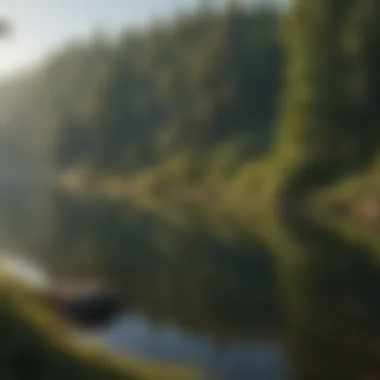Exploring Jordan Lake: Ecology and Conservation Insights


Intro
Jordan Lake represents a unique intersection of natural beauty and ecological significance within the broader landscape of American forests. This water body, along with its surrounding ecosystems, serves as a microcosm for examining various ecological and conservation themes relevant to contemporary environmental discourse. The integration of recreational activities with biodiversity and conservation challenges creates an intricate tapestry worth exploring in detail.
Within this investigation of Jordan Lake, we will explore its various dimensions, such as the prominent insights related to its geographical features, the diversity of flora and fauna, the pressures caused by human activities, and the ongoing initiatives aimed at preserving its ecological integrity. Understanding these components is essential for acknowledging Jordan Lake's role not only as a local resource but as a vital element in the sustained health of American forest ecosystems.
This article aims to provide a comprehensive study, appealing particularly to forestry professionals and academics who require detailed analyses of environmental conditions and ecological relationships. The relevance of this study extends beyond mere observations, prompting discussions regarding sustainable interactions with our natural resources and informing best practices that can be applied to similar ecosystems.
Prologue to Jordan Lake
Understanding the context of Jordan Lake is crucial for appreciating its ecological value and its role in the surrounding environment. Jordan Lake serves not just as a recreational venue, but also as a vital component of regional biodiversity and water quality management. Recognizing its geographical and historical dimensions provides insight into the challenges and opportunities that the lake presents.
Geographical Location
Jordan Lake is situated in the midst of North Carolina, adjacent to the towns of Apex, Cary, and Chatham County. The lake spans approximately 13,940 acres, encompassing varied landscapes that include wetlands, forests, and open water. This geographical positioning makes it a resource for various nearby communities, supporting both local ecosystems and human activities.
The lake is a reservoir created by damming the Haw River and serves several purposes including flood control, drinking water supply, and recreational activities. Its proximity to the Research Triangle area enhances its importance, as this region is a hub for education and research. This location also facilitates easy access for professionals and academics, who often study its diverse ecological components.
Notably, the lake is part of the larger Cape Fear River Basin, an area that significantly influences the hydrology and ecology of the region. Monitoring water levels and quality in Jordan Lake provides insights into broader environmental trends affecting the Cape Fear Basin.
Historical Background
The history of Jordan Lake dates back to the construction of its dam in the mid-1970s, primarily driven by the need for flood control and water supply management. The lake was formed as a response to previous flooding patterns that had impacted local communities. Today, it stands as a reflection of how human intervention can reshape natural environments to meet societal needs.
Over the years, Jordan Lake has evolved from a project aimed mainly at utility purposes to a recognized ecological haven. Studies show that the lake supports a myriad of wildlife and has become a critical habitat for various fish, bird species, and other wildlife. Public awareness of its ecological richness has grown following efforts to protect and study its ecosystems.
Moreover, the interplay of historical decisions regarding land use and development has shaped the current landscape of Jordan Lake. The balance of preserving ecological integrity while facilitating human activities remains a constant challenge. Understanding this history unveils the ongoing relationship between humans and nature in the Jordan Lake area.
"Jordan Lake exemplifies the intricate relationship between environmental management and the preservation of natural resources."
Ecological Significance of Jordan Lake
Understanding the ecological significance of Jordan Lake is crucial. This lake serves multiple roles in supporting both local ecosystems and the broader environment. The lake is a vital resource for numerous species, providing habitat and sustenance. Its health directly impacts not just the wildlife that depend on it, but also the communities surrounding it. By exploring water quality, aquatic ecosystems, and terrestrial biodiversity, we get a complete view of the ecosystem's complexity and its interconnectedness.
Water Quality Assessment
Water quality is a fundamental aspect of Jordan Lake's ecological health. Several factors affect this quality, including nutrient levels, pollutants, and sedimentation. Regular assessments help to monitor these elements, which can point to larger systemic issues within the ecosystem. High levels of nutrients can lead to algal blooms, which can deplete oxygen in the water and harm fish and other aquatic life. Monitoring programs often focus on the levels of phosphorus and nitrogen, as they play significant roles in water quality.
The presence of pollutants, which may originate from urban runoff or agricultural practices, can also degrade water quality. These pollutants can harm aquatic species and pose risks to human health. Thus, systematic water quality assessments are essential. They inform regulations and management strategies aimed at ensuring the lake remains a healthy ecosystem.
Aquatic Ecosystems
The aquatic ecosystems of Jordan Lake are diverse and complex. These ecosystems support various species, including fish, invertebrates, and aquatic plants. The interplay between these organisms creates a dynamic environment that contributes to the lake's overall ecological balance.
Certain species are indicators of ecosystem health. For example, the presence of certain fish species may signify good water quality and diverse habitats. Conversely, a decline in fish populations can alert ecologists to potential problems. Understanding these relationships is crucial for effective management and conservation strategies.
Human activities also impact these ecosystems. Recreational fishing and boating can disturb habitats and affect wildlife. It is important to balance recreational use with healthy ecosystem management to ensure these aquatic ecosystems continue to thrive.


Terrestrial Biodiversity
Terrestrial biodiversity around Jordan Lake complements the aquatic ecosystems. The surrounding land provides habitats for various species, from birds and mammals to insects and plants. This biodiversity serves several functions, including soil stabilization and nutrient cycling. It plays a role in supporting the lake's health by filtering runoff and reducing erosion.
Moreover, the different plant communities influence water quality and habitat structure within the lake. Vegetation can trap sediments and absorb nutrients before they reach the water, promoting better water quality. The interdependence between terrestrial and aquatic environments highlights the importance of maintaining biodiversity in all its forms.
Maintaining the ecological balance of Jordan Lake is not just about protecting the lake itself, but also about ensuring the surrounding ecosystems are preserved.
Recreational Opportunities
Recreational activities at Jordan Lake are not simply pastimes; they serve as integral components that enhance both community engagement and appreciation for natural ecosystems. The lake attracts a diverse group of visitors—from families to individual adventurers—providing multiple avenues to connect with the environment. Understanding these opportunities not only informs how we engage with the space but also highlights the necessary balance between recreation and conservation efforts.
Fishing and Angling
Fishing remains one of the most popular activities at Jordan Lake. The lake is home to various fish species, including bluegill, largemouth bass, and catfish. While angling provides an enjoyable pastime, it also supports local economies. Many commercial fishing operations rely on the lake’s sustainable fish population. However, potential anglers should familiarize themselves with applicable regulations that govern fishing licenses and seasons to ensure responsible practices. Early morning or late afternoon are often the best times for fishing, providing a tranquil environment to enjoy this activity.
Water Sports Activities
Jordan Lake offers diverse water sports opportunities. Activities such as kayaking, paddleboarding, and jet skiing are prevalent among visitors. These sports not only provide exercise but also foster a sense of adventure. Additionally, they offer a unique perspective of the lake's ecological features. Before engaging, it is crucial to be aware of safety measures and any restrictions on specific areas to maintain the ecological balance of the lake waters. More so,
Water sports can sometimes lead to increased boat traffic, which may disrupt the habitats of aquatic species. It is essential to be conscious of one’s impact on the ecosystem while enjoying these activities.
Hiking and Trails
The hiking trails around Jordan Lake provide an important opportunity for exploration and appreciation of terrestrial biodiversity. Many designated paths offer varying levels of difficulty, appealing to both casual walkers and serious hikers. The trails not only afford scenic views of the lake but also serve as gateways to diverse habitats. Observers may catch glimpses of wildlife, enriching the hiking experience. Furthermore, hiking promotes physical health and could serve as a powerful tool in education about environmental stewardship. Visitors are encouraged to respect trail markers and avoid disturbances to the natural environment, ensuring trails remain pristine for future generations.
Impact of Human Activity on Jordan Lake
Human activity has a profound influence on natural ecosystems. In the context of Jordan Lake, this impact manifests in urban development, pollution challenges, and the introduction of invasive species. Understanding these factors is essential, as they dictate the health and sustainability of the lake's environment.
Urban Development
Urban expansion around Jordan Lake has significantly altered its natural landscape. New residential and commercial structures have disrupted habitats. Loss of wetlands is one significant consequence of this development. Wetlands help in filtering pollutants and provide habitat for various species.
Construction activities often lead to increased runoff, which carries sediment and pollutants directly into the lake. This runoff contributes to the degradation of water quality. Moreover, the increase in impervious surfaces leads to more stormwater entering the lake. As a result, the lake experiences higher levels of nutrients, fostering harmful algal blooms that threaten aquatic life.
Pollution Concerns
Pollution remains a critical concern for Jordan Lake. Various sources contribute to this issue.
- Agricultural runoff introduces pesticides and fertilizers into the water, which disrupt aquatic ecosystems.
- Wastewater discharge from urban areas adds to the lake's contamination.
- Littering and illegal dumping create immediate hazards for both wildlife and humans.
Efforts to monitor and regulate these sources are ongoing. However, public awareness and active community involvement are essential to mitigate these pollution impacts.
Pollution not only affects water quality but also poses risks to human health and local wildlife.
Invasive Species Challenges


The introduction of invasive species is another aspect of human activity impacting Jordan Lake. Non-native species often outcompete local flora and fauna for resources.
Common invasive species in the lake include:
- Curb Crabgrass
- Purple Loosestrife
- Zebra Mussels
These species can alter habitats, disrupt food webs, and reduce biodiversity. Over time, invasive species can lead to a decline in native populations, altering the lake's ecological balance.
Mitigating these challenges requires coordinated efforts. Monitoring programs, public education, and removal initiatives are all critical steps in combatting the influence of invasive species.
Conservation Efforts and Initiatives
The conservation efforts and initiatives in and around Jordan Lake hold paramount importance in the context of sustaining its ecological health. These initiatives are designed to mitigate adverse impacts on the environment, while fostering biodiversity and promoting sustainable recreational activities. Focusing on conservation helps protect wildlife habitats, ensure water quality, and maintain the overall integrity of the ecosystem. Effective conservation practices positively influence local communities, enhance educational opportunities, and maintain the ecological services the lake provides.
Local Conservation Groups
Local conservation groups play a critical role in the stewardship of Jordan Lake. These organizations operate at the grassroots level, mobilizing community members to participate in various conservation activities. They often organize clean-up events, educational workshops, and habitat restoration projects. One prominent group is the Jordan Lake Foundation, which engages the public in conservation efforts and raises awareness about the lake's ecological significance.
Their activities may include:
- Monitoring water quality and reporting findings to relevant authorities.
- Promoting responsible fishing practices and encouraging anglers to adhere to size and bag limits.
- Conducting educational campaigns directed at schools and local communities.
Such efforts not only nurture a sense of responsibility among residents but also lead to tangible improvements in the lake's health and surrounding environment.
State and Federal Support
State and federal support is essential in bolstering conservation initiatives. Government agencies often provide funding, technical assistance, and regulatory frameworks that promote sustainable practices in managing Jordan Lake. The North Carolina Department of Environmental Quality actively monitors the health of the lake and implements policies aimed at environmental protection. Furthermore, federal programs like the Clean Water Act offer incentives for projects aimed at improving water quality and ecosystem resilience.
These programs help to:
- Facilitate research into ecological challenges and what is effective in overcoming them.
- Fund projects that restore wetlands, improve water quality, and control runoff.
- Enhance collaboration among various stakeholders, including local governments and conservation organizations.
Such supports create a unified approach in combating threats to Jordan Lake, binding local efforts with broader initiatives.
Community Involvement
Community involvement is central to the success of conservation efforts at Jordan Lake. Engaging local citizens fosters a collective commitment to preserving the environment. Public participation can be encouraged through volunteer programs that invite residents to contribute their time and skills to ongoing conservation efforts.
Community actions may include:
- Participating in lake cleanup days to remove litter and debris.
- Reporting sightings of invasive species to local environmental authorities.
- Attending workshops on sustainable practices such as native planting in yards or responsible boating.
By involving the community in these processes, it creates a sense of ownership and accountability.
Collective effort and active participation from local communities remain fundamental in safeguarding Jordan Lake for future generations.
Overall, the synergies among local groups, state support, and community involvement are critical components in enhancing Jordan Lake's capacity to withstand and adapt to environmental pressures.


Future Directions for Jordan Lake
The future directions for Jordan Lake are crucial for understanding its ecological sustainability and ecological preservation. They serve to highlight the path forward that can protect this natural resource while accommodating the needs of the community. It is essential to recognize how engaging with local stakeholders and utilizing innovative practices can lead to improved outcomes for both the lake and the people who depend on it.
Sustainability Practices
Sustainability practices for Jordan Lake involve a combination of strategies aimed at minimizing human impact on this vital ecosystem. Implementing best management practices can help maintain water quality, protect habitats, and preserve biodiversity.
Key areas of focus may include:
- Buffer zones: Planting native vegetation along the shoreline to reduce runoff and improve water filtration.
- Erosion control: Using natural barriers and erosion control mats to prevent soil loss along vulnerable areas.
- Waste management: Implementing stricter regulations on waste disposal in surrounding areas to minimize pollution.
Educating the public about the importance of these practices can ensure greater compliance and participation in conservation efforts. For example, workshops and community events can raise awareness and promote a sense of stewardship among residents.
Monitoring and Research
Ongoing monitoring and research are fundamental to understanding the health of Jordan Lake and its surrounding environment. Establishing data collection programs that assess various environmental factors will provide valuable insights into changes in the ecosystem over time.
Effective monitoring should focus on:
- water quality parameters, such as pH, turbidity, and nutrient levels t- species populations, especially vulnerable or invasive species
Collaboration between local universities, environmental groups, and government agencies can enhance research efforts. Sharing findings openly can allow for a comprehensive analysis and enable informed decision-making regarding conservation policies.
"Without proper monitoring, we risk losing crucial data that informs conservation strategies."
Long-term Vision for Conservation
A long-term vision for conservation at Jordan Lake should encompass a blend of immediate actions and sustained efforts aimed at protecting this ecosystem for future generations. Developing a comprehensive conservation plan that outlines clear goals and timelines is essential.
This plan could address:
- Habitat restoration initiatives to support native flora and fauna
- Education programs for local schools to foster an appreciation for local ecology
- Partnerships with environmental organizations to leverage resources and expertise
It is vital for all stakeholders to remain engaged in this vision, ensuring it adapts over time in response to evolving challenges. By striving to balance human activity with environmental health, the legacy of Jordan Lake can be preserved.
Culmination
Understanding the various aspects of Jordan Lake is crucial not only for its ecological health but also for the communities surrounding it. This article has ventured deep into the lake's environment and ecology, highlighting its significance within a broader environmental context. Its health impacts local biodiversity, recreational opportunities, and even economic factors linked to tourism and conservation.
Summary of Findings
Throughout this study, several key points emerged:
- Ecological Importance: Jordan Lake serves as a habitat for diverse species, making it a vital ecological asset. This biodiversity is essential for maintaining the ecological balance.
- Human Impact: Urban development and pollution are significant threats to the lake's health. Understanding these factors is essential for implementing effective conservation strategies.
- Conservation Initiatives: Community and governmental efforts are underway to mitigate negative impacts. Local conservation groups play a key role in these initiatives.
- Future Directions: Sustainable practices and continuous monitoring are necessary to ensure the long-term health of Jordan Lake.
"The integrity of Jordan Lake is intertwined with the ecological and social fabric of the surrounding region."
Call for Continued Engagement
The findings presented in this article highlight the importance of ongoing engagement with Jordan Lake's conservation. As stakeholders, including local residents, forestry professionals, and academics, it is essential to foster collaboration. By increasing awareness of the lake's challenges and successes, we can collectively contribute to its preservation.
Continuing to support conservation efforts, participating in community initiatives, and advocating for sustainable practices can significantly influence the health of Jordan Lake. Research and monitoring efforts must keep pace with changes in the environment to adapt strategies effectively. Active participation from the community ensures that the lake remains a recreational asset and a healthy ecosystem for future generations.



